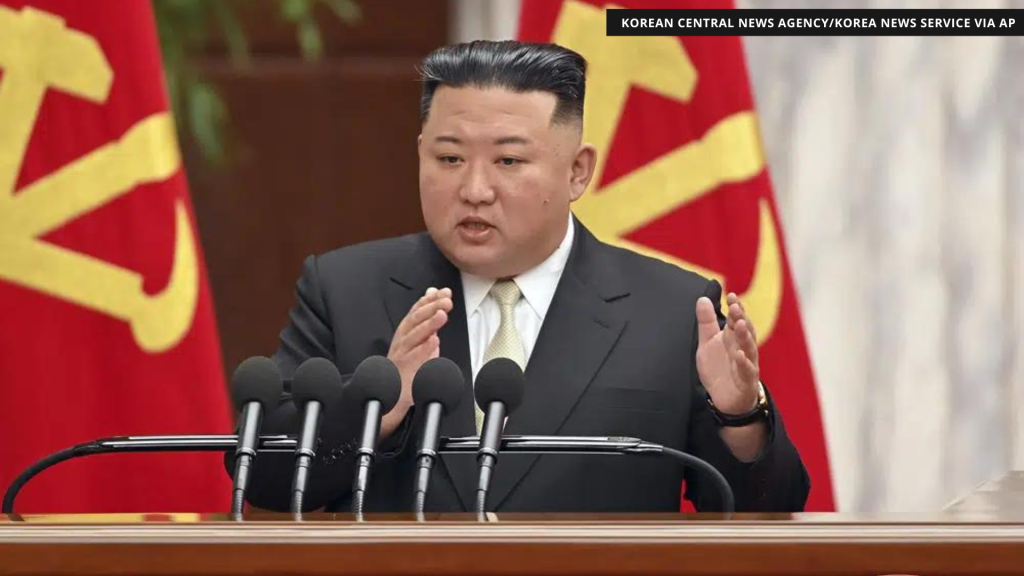SEOUL, South Korea (AP) — North Korean leader Kim Jong Un vowed to strengthen state control over agriculture and take a spate of other steps to increase grain production, state media reported Thursday. But experts say it won’t effectively address a worsening food shortage.
Kim’s measures unveiled during a recent four-day meeting were largely a repeat of his past policies. Prospects for quickly resolving its food insecurity are dim, as North Korea restricts the operation of markets and devotes much of its scarce resources to its nuclear program.
While experts believe the food situation is the worst it has been under Kim’s 11-year rule, they still say they see no signs of imminent famine or mass deaths.
During the ruling Workers’ Party meeting that ended Wednesday, Kim said his government sees agricultural development as a matter of “strategic” importance and that farming goals should be settled without fail, according to the official Korean Central News Agency.
“In order to attain the gigantic long-term objective of rural development, it is necessary to decisively strengthen the party guidance over the agricultural sector and improve the rural party work,” Kim was quoted as saying.
Kim also ordered officials to overcome unspecified “lopsidedness in the guidance on farming” and concentrate on increasing farm yields. He said provincial, city and county authorities must boost their guidance on agriculture.
KCNA didn’t elaborate how Kim would reinforce his government’s guidance on farming. But experts say Kim’s instructions were a reaffirmation of his push to restore elements of a socialist-style planned economy — under which a central authority controls the market rather than participants — on grain supply. They say that’s one of the factors behind North Korea’s worsened food situation.
“In our views, they’re going backward and returning to the past,” said Kwon Tae-jin, a senior economist at the private GS&J Institute in South Korea. “To resolve the food problem, they should let markets play a greater role. But they’re rather returning to a planned economy.”
South Korea’s Unification Ministry said later Thursday that North Korea is expected to use local organizations in rural towns to maintain their control of the people, mobilize them as labor forces and implement previous policies. It expressed skepticism about whether Kim’s push to tighten guidance over agricultural activities would lead to meaningful improvements unless it’s backed by the supply of fertilizer and other key agricultural materials.
North Korea’s state rationing system remains largely broken since a crippling famine killed an estimated hundreds of thousands of people in the mid-1990s. The country had since tolerated some levels of open market activities, a move that experts say has helped the North achieve a slow, modest economic growth but could eventually pose a threat to its authoritarian leadership by the Kim family.
North Korea’s chronic economic difficulties and food insecurity have deepened with toughened United Nations sanctions, the COVID-19 pandemic that decimated its external trade, and the North’s own mismanagement.
Further aggravating its food shortage was authorities’ unsuccessful attempts to supply grain via state-run facilities while restricting private dealings at markets. Other factors attributed to the food shortage include dwindling personal incomes and sharply decreased unofficial grain purchases from China due to the pandemic curbs, Kwon said.
“Market participants are still very cautiously acting, so the volume of grain at markets hasn’t increased much,” Kwon said. “If authorities view markets negatively, they can’t be properly recovered.”
Lim Eul-chul, a professor at Kyungnam University’s Institute for Far Eastern Studies in Seoul, said the latest North Korean meeting was meant to review the progress in existing long-term strategies to improve national food production, remind officials of related goals and discuss ways to implement them.
But he said there was still no description of meaningfully new strategies or direction.
The Unification Ministry said North Korean state media’s lack of detailed assessments about the long-term strategies’ accomplishments indicates that progress has been slow.
North Korea’s 2022 grain production was estimated at 4.5 million tons, a 3.8% drop from a year earlier, according to South Korean assessments. In the previous decade, its annual production was an estimated 4.4 million to 4.8 million tons. South Korea’s spy agency has said North Korea needs 5.5 million tons of grain to feed its 25 million people each year.
The plenary meeting of the ruling party’s Central Committee heavily concentrated on agriculture. That could be an acknowledgement the food situation is serious, but some experts say the country also likely aims to burnish Kim’s image as a leader caring for his people and boost domestic support of his push to expand his nuclear arsenal.
During the meeting, Kim also called for officials to build new irrigation systems, supply more efficient farming machines and convert more tideland into farmland. He urged authorities to provide all available assistance to rural farming communities and the public to rally behind his leadership to attain agricultural goals.
“It is difficult to be optimistic about the food supply as long as Pyongyang insists on implementing North Korean-style socialism and isolating the country from international trade and assistance while developing nuclear missiles,” Leif-Eric Easley, a professor at Ewha University in Seoul, said.
While North Korea is about 1 million tons of grain short of sufficient annual levels, Lim said that such degrees of shortages have not resulted in mass famines in the past. Kwon said food is still available at markets, though at expensive prices.
“It’s like very poor people are starving but the government won’t let them die of hunger. Things could continue like that,” Kwon said.

Copyright 2023 by the Associated Press. All Rights Reserved.
Tune in live for more on the stories that matter to you: WMAL.com | WMAL app | “Alexa, play W-M-A-L”
Follow WMAL on social media: Twitter, Facebook, Instagram, Youtube, Rumble, Gettr and Parler




















